How to Stay Positive During Chronic Illness: A Guide to Emotional Strength and Hope
Introduction
Living with a chronic illness changes everything. Your body becomes unpredictable, your energy limited, and your sense of control fragile. Some days, even getting out of bed can feel like a victory.
And yet, beneath the exhaustion and uncertainty lies a quiet truth: positivity isn’t about denying your pain — it’s about choosing meaning in the middle of it.
Staying positive during chronic illness doesn’t mean smiling through suffering or pretending to be strong all the time. It means learning how to navigate hard days with grace, compassion, and small acts of self-nourishment that remind you that your life still holds beauty, connection, and purpose.
This article explores how to protect your mental and emotional well-being when your body feels like a battlefield — and how to rebuild a life that feels good, even when things aren’t perfect. 🌸
Looking for supplements for this? Click here.
🌧️ The Emotional Landscape of Chronic Illness

Chronic illness isn’t just a medical condition — it’s an emotional journey. It alters how you see yourself, relate to others, and plan your future.
Common Emotional Challenges
Loss of identity: You may grieve the person you were before diagnosis.
Isolation: Fatigue, mobility issues, or stigma can make you feel cut off.
Fear of the future: Uncertainty about symptoms or flare-ups creates anxiety.
Guilt: You might feel like a burden or “too much” for loved ones.
Frustration: When your mind wants more than your body can give.
These feelings are not signs of weakness — they are signs of being human.
🪷 Acknowledging pain doesn’t erase hope; it makes hope real.
🌞 Step 1: Redefine What “Positivity” Really Means
Many people equate positivity with constant cheerfulness — but for someone living with chronic illness, that’s unrealistic and exhausting.
🌿 Real Positivity = Emotional Honesty + Gentle Hope
True positivity is the ability to hold both truths at once:
“This is really hard” and “I’m still capable of finding moments of peace.”
It’s giving yourself permission to feel pain without drowning in it, and choosing gratitude even on days that feel impossible.
💬 Positivity is not perfection; it’s presence.
🌸 Step 2: Practice Radical Self-Compassion
Chronic illness demands self-compassion more than self-discipline. Your body isn’t failing you — it’s fighting to protect you.
Instead of pushing through pain or comparing yourself to others, speak to yourself like you would to a dear friend.
💗 Try This
When your body feels weak, say:
“I’m proud of myself for showing up today.”
“I am more than what I can do.”
“My worth isn’t measured by productivity.”
According to Dr. Kristin Neff’s research, self-compassion lowers cortisol and activates the body’s healing response.
🌿 Your body listens to how you speak to it.
🌙 Step 3: Allow Grief to Exist
Positivity and grief can coexist. Many people with chronic illness feel pressure to “stay strong,” but that often suppresses necessary emotion.
💬 Permission to Feel
Grieve the losses — energy, mobility, spontaneity.
Cry without guilt.
Write letters to your old self.
Honor what you’ve endured.
Grief doesn’t mean giving up; it means making space for acceptance.
🪶 Healing begins when you stop pretending you’re not hurting.
🌿 Step 4: Regulate Your Nervous System
When you live with constant pain or uncertainty, your nervous system often stays in “fight or flight.” This creates a loop of tension, anxiety, and fatigue.
🌬️ Calming Techniques
Breathwork (4-7-8 breathing):
Inhale 4s → Hold 7s → Exhale 8s — repeat 5 times.
Grounding:
Feel your feet on the floor, notice 3 things you see, 3 you hear, 3 you can touch.
Vagus Nerve Activation:
Gentle humming or singing.
Splashing cool water on your face.
Long exhales during deep breathing.
Body Scan Meditation:
Move awareness through each body part and thank it, even the painful ones.
These small tools signal safety to the body, which in turn reduces inflammation, stress hormones, and emotional volatility.
🪷 You can’t always calm your illness, but you can calm your nervous system.
Want to try Breathwork? Click Here.
🌤️ Step 5: Focus on Micro-Moments of Joy
When your world shrinks because of illness, so must your definition of joy.
Joy no longer needs to be grand — it can be subtle, quiet, fleeting.
✨ Practice “Micro-Joy Awareness”
The warmth of sunlight through your window ☀️
A song that feels like a hug 🎶
The smell of morning coffee ☕
A text from someone who understands 💬
Training your brain to notice these moments rewires neural pathways toward gratitude and contentment — even in pain.
💚 Joy isn’t found by escaping your reality but by seeing its small miracles.
🌸 Step 6: Rebuild Your Relationship with Time
Chronic illness often steals the sense of continuity — the “before” and “after” version of you. You may feel like you’re living on pause.
To rebuild hope, focus on the present, not the timeline.
🌿 Try This
Instead of: “When I get better, I’ll be happy.”
Say: “Today, I’ll find one small thing that feels good.”
Each moment you honor now — even five peaceful minutes — strengthens your emotional stability.
🪷 Healing happens in moments, not milestones.
🌻 Step 7: Redefine Productivity
In a world that glorifies doing, illness forces you to rediscover the value of being.
Productivity is not about quantity — it’s about alignment.
You may not manage a to-do list, but you are managing a battle your body fights silently every day.
Celebrate quiet victories:
Showering on a hard day 🚿
Making a meal 🍲
Saying no to protect your energy 🙅
Resting without guilt 💤
💬 Rest is productive when you’re healing.
🌼 Step 8: Cultivate Mental Flexibility
Resilience during illness isn’t about control — it’s about adaptation.
You may not choose your symptoms, but you can choose your response to them.
🧠 Build Cognitive Flexibility
Reframe: “I’m stuck in bed” → “I’m giving my body the space it needs.”
Shift expectations based on your energy levels.
Replace “I can’t” with “Not today, but maybe later.”
Mental flexibility lowers stress and improves emotional well-being by keeping you open to possibility instead of trapped in rigidity.
🌿 Flexibility is the quiet form of strength.
💞 Step 9: Nurture Your Support Network
Isolation intensifies pain — emotionally and physically.
Having people who “get it” can restore hope faster than any treatment.
🤝 Build Your Circle
Communicate your needs clearly: “I’d love to talk, but please just listen today.”
Join chronic illness communities online or locally.
Let loved ones in: Allow help without guilt — they want to feel useful too.
Even a few moments of authentic connection can release oxytocin, lowering cortisol and calming your heart rate.
💚 Connection doesn’t fix illness, but it heals loneliness.
🌙 Step 10: Protect Your Energy
People with chronic illness often have limited “spoons” — a metaphor for daily energy units.
Learning to spend your spoons wisely is key to staying positive.
🌸 Energy Management
Prioritize essentials: What truly matters today?
Say no kindly but firmly.
Use energy-saving tools (mobility aids, delivery services, prepared meals).
Schedule “recovery days” after activity.
💬 Protecting energy is not laziness — it’s wisdom born from self-awareness.
🌿 Step 11: Reconnect to Meaning
When your body changes, purpose can feel distant. Yet, meaning is what transforms endurance into empowerment.
Ask:
“What still gives me a sense of purpose?”
“Who can I help or inspire through my story?”
“How can I create beauty even within limitation?”
Maybe meaning looks like helping others online, writing, or nurturing plants on your windowsill.
🪷 Purpose gives pain a direction.
🌞 Step 12: Use Your Mind–Body Connection for Healing
Your thoughts can’t cure illness — but they can influence how your body experiences it.
🌬️ Practices That Support Healing
Visualization: Imagine your body surrounded by healing light.
Gentle movement: Yoga, stretching, or breathing can increase circulation and mood.
Mindfulness meditation: Lowers inflammation and improves pain perception.
Scientific studies show mindfulness reduces activity in the pain-processing centers of the brain.
💚 A calm mind softens the edges of suffering.
🌻 Step 13: Manage Health Anxiety
Living with chronic illness often creates hypervigilance — constant scanning for new symptoms or worst-case scenarios.
This mental loop drains positivity.
🌿 How to Recenter
Limit excessive online symptom searches.
Ground in facts from trusted professionals.
Practice body neutrality: observe sensations without labeling them “good” or “bad.”
Keep a “worry window” — set 15 minutes daily to write fears, then close it.
🧘 You don’t need to fight every thought — you just need to stop believing all of them.
🌸 Step 14: Balance Acceptance and Hope
Acceptance isn’t giving up — it’s giving up the fight against what is.
When you stop demanding that life look different, peace arrives.
From peace, hope becomes realistic — not naive.
💬 Acceptance says, “This is my body today.”
Hope says, “Tomorrow, I can still grow.”
Together, they form emotional resilience. 🌿
Looking for online therapy ? Click Here.
🌿 Step 15: Heal Through Creativity

Creativity is therapy for the soul. Whether you write, draw, play music, or photograph small moments, creative expression externalizes emotion.
It helps your nervous system process grief, beauty, and meaning simultaneously.
🎨 Try:
Journaling about your day’s emotional “temperature”
Painting abstractly with colors that reflect your mood
Writing poems or short reflections
Listening to or making music
🪶 Creativity transforms pain into poetry.
🌞 Step 16: Redefine Relationships
Illness reshapes how you relate to others. Some friendships fade; others deepen.
💬 How to Stay Emotionally Healthy
Communicate openly: “I still want connection, even if I can’t show up the same way.”
Let go of those who don’t understand — it’s not your fault.
Seek people who bring peace, not pressure.
💗 You deserve relationships that adapt with your reality, not ones that punish it.
🌿 Step 17: Celebrate Small Victories
When progress feels slow, focus on micro-achievements.
Every small win — a walk outside, a symptom-free hour, a new coping skill — rewires your brain toward optimism.
Keep a “Victory Journal” to track them. Over time, you’ll see how strong you truly are.
🌸 Tiny steps, when repeated, build mountains of resilience.
🌙 Step 18: Manage Setbacks with Grace
Flare-ups happen — and they can crush motivation.
During setbacks:
Acknowledge disappointment without judgment.
Rest unapologetically.
Avoid catastrophizing (“This will never end”).
Return to your breath and remind yourself: “This is temporary.”
Even during relapse, you haven’t lost progress — you’re just practicing patience in a new chapter.
💬 Resilience is grace under repeat trials.
🌻 Step 19: Use Affirmations for Mental Rewiring
Affirmations aren’t denial; they’re reminders.
Say daily:
“I am more than my illness.”
“I’m learning patience and strength.”
“My body and I are on the same team.”
“I deserve peace even in uncertainty.”
Neuroscience shows repetition of positive self-talk rewires the default mode network of the brain, reducing rumination and despair.
🌿 Words are medicine for the mind.
🌞 Step 20: Seek Professional Emotional Support
Therapy or support groups for chronic illness can be transformative.
Cognitive Behavioral Therapy (CBT): helps manage catastrophic thoughts.
Acceptance and Commitment Therapy (ACT): teaches acceptance with purpose.
Somatic therapy: connects body sensations to emotional healing.
Support groups: offer community and shared wisdom.
💬 You’re not weak for needing help — you’re wise for asking for it.
Looking for online therapy ? Click Here.
🌸 Step 21: Practice Gratitude for What Remains
Gratitude doesn’t mean pretending everything’s fine — it means acknowledging what still brings light.
Every day, write down 3 things that comfort you — no matter how small:
A gentle breeze
A kind message
A symptom-free morning
Over time, your focus shifts from what’s missing to what’s meaningful.
🪷 Gratitude is the heartbeat of resilience.
🌿 Step 22: Accept Rest as an Act of Resistance
In a productivity-obsessed world, rest feels radical.
But for the chronically ill, rest is not optional — it’s essential.
When you rest, you’re not falling behind — you’re aligning with your body’s truth.
🌙 Rest is how the body remembers it’s safe.
🌻 Step 23: Find Purpose Beyond Productivity
Your worth is not in output but in essence.
Even if illness limits what you can “do,” your presence still matters — deeply.
The compassion, patience, and empathy you’ve developed are gifts to others.
💚 Your story is medicine for someone else’s pain.
🌸 Step 24: Anchor Yourself in Faith or Philosophy
Whether through spirituality, nature, or mindfulness, connection to something greater than yourself restores perspective.
Meditation, prayer, or quiet reflection remind you:
You are part of something vast and meaningful — even when life feels small.
🌿 Faith is the bridge between what hurts and what heals.
🌞 Step 25: Remember That You Are Still Whole
Illness may change your body, but it can never erase your soul.
Even on days you feel fragile, your spirit remains intact — strong, luminous, resilient.
“Wholeness isn’t about being unbroken. It’s about embracing yourself completely — scars, symptoms, and all.” 🌿
You are not your illness.
You are the person living through it — with courage, heart, and light.
💫 Final Thoughts
Staying positive during chronic illness isn’t about pretending everything’s okay.
It’s about cultivating a mindset rooted in self-compassion, gratitude, and hope — one that honors your pain but also celebrates your perseverance.
🌿 You are allowed to rest.
🌸 You are allowed to feel.
💚 You are allowed to find joy again.
“You are not behind in life — you are rewriting what strength looks like.”
Even in limitation, you are living a story of extraordinary resilience.
📚 References
Neff, K. (2011). Self-Compassion. HarperCollins.
Kabat-Zinn, J. (2013). Full Catastrophe Living. Random House.
McEwen, B. S. (2007). Physiology and neurobiology of stress and adaptation. Physiological Reviews.
Siegel, D. J. (2010). The Mindful Brain. W.W. Norton & Company.
Van der Kolk, B. (2014). The Body Keeps the Score. Penguin Books.
Seligman, M. E. P. (2011). Flourish. Free Press.
Frankl, V. (2006). Man’s Search for Meaning. Beacon Press.
Lazarus, R. S. (1991). Emotion and Adaptation. Oxford University Press.
Walsh, R. (2011). Lifestyle and mental well-being. American Psychologist.
Hanson, R. (2013). Hardwiring Happiness. Harmony Books.
Related Posts
-
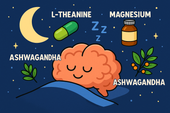
Nootropics That Promote Calm and Rest
Explore the world of calming nootropics — natural brain enhancers that promote relaxation, better focus, and deeper rest. Learn how L-Theanine, magnesium, ashwagandha, and other adaptogens help balance your nervous system, reduce stress, and support restorative sleep.
-

Best Natural Supplement Stack for Sleep
Discover the best natural supplement stack for deep, restorative sleep. Learn how nutrients like magnesium, L-theanine, glycine, and calming herbs such as chamomile and ashwagandha work together to relax your body, calm your mind, and improve sleep quality—naturally and safely.
-

Combining L-Theanine and Magnesium for Sleep: A Calm Night, Naturally
Discover how combining L-Theanine and Magnesium can help you drift into deep, restorative sleep. Learn how this natural duo calms the mind, relaxes the body, and supports your nervous system—without grogginess the next morning.
-

How to Sleep Better After Intense Workouts
Struggling to fall asleep after a tough workout? Learn how to optimize your post-training recovery with nutrition, hydration, and science-backed sleep strategies. Discover how to calm your nervous system, balance hormones, and wake up fully recharged for your next session.
-

Ashwagandha and Valerian: A Bedtime Combo for Deep Rest and Emotional Reset
Discover the calming synergy of Ashwagandha and Valerian root, two natural sleep aids that help quiet the mind, ease anxiety, and promote deeper rest. Learn how this herbal duo supports the nervous system, balances stress hormones, and restores emotional peace — without next-day grogginess.
-
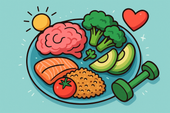
How to Create a Resilience-Boosting Diet
Discover how to build emotional and physical strength from the inside out with a resilience-boosting diet 🍎. Learn which foods stabilize your mood, how supplements like magnesium and omega-3s strengthen your stress response, and why pairing nutrition with breathwork and therapy creates lasting calm, focus, and vitality 🌿💪.
-

Best Teas and Herbal Blends for Calmness: Nature’s Way to Restore Inner Peace
Ashwagandha, the ancient adaptogenic herb, helps your body find balance during stress. Known as “Indian ginseng,” it supports cortisol regulation, boosts energy, and restores calm clarity. Discover how this powerful root promotes resilience, emotional balance, and steady vitality — one cup at a time. 🌸
-

Parenting and Emotional Strength: How to Raise Children Without Losing Yourself
Empathy is the bridge that connects hearts — the quiet power to understand, feel, and support another’s emotions without judgment. Learn how empathy strengthens relationships, enhances communication, and cultivates deeper compassion in everyday life. 🌿
-
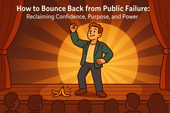
How to Bounce Back from Public Failure: Reclaiming Confidence, Purpose, and Power
Visualization is more than imagination — it’s brain training for resilience. By picturing calm, success, or healing, you activate the same neural pathways as real experience. Learn how daily visualization rewires your brain for confidence, emotional balance, and recovery from stress. ✨
-

Coping with Financial Stress Through Resilience: How to Stay Grounded When Money Feels Tight
Body awareness is the foundation of emotional resilience. By tuning into your body’s signals — tension, fatigue, or calm — you learn to recognize stress before it overwhelms you. Discover how mindfulness, gentle movement, and breathwork can deepen your connection with your body and restore balance from the inside out. 🧘
-
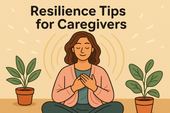
Resilience Tips for Caregivers: How to Stay Strong While Caring for Others
Joy isn’t the absence of pain — it’s the quiet strength to find light even in challenging times. Cultivating joy through small daily moments restores balance, releases stress, and reminds you of life’s beauty. Learn how to reconnect with authentic happiness, rebuild emotional energy, and nurture your nervous system through gratitude, presence, and play. 🌿
-

Building Resilience After a Breakup: How to Heal, Rebuild, and Rise Stronger
Social connection is one of the strongest predictors of emotional resilience. During difficult times, genuine relationships act as anchors — calming the nervous system, reducing stress hormones, and helping you regain perspective. Learn how cultivating real human connection can strengthen your mind, heart, and overall well-being. 🌿
-

How to Stay Emotionally Strong During Job Loss
Your emotions are powered by brain chemistry — a delicate balance of neurotransmitters like serotonin, dopamine, and cortisol. When these chemicals work in harmony, you feel calm, focused, and resilient. Learn how daily habits, nutrition, and mindfulness can support your brain chemistry and boost emotional well-being naturally. 🌿
-

The Role of Hormones in Emotional Stability: How Your Chemistry Shapes Your Calm
Hormones shape more than your body — they shape your emotions, resilience, and sense of calm. From cortisol to serotonin, these chemical messengers influence how you react to stress, connect with others, and recover from challenges. Learn how to balance your hormones naturally to build lasting emotional stability and harmony within. 💫
-

Mitochondria and Emotional Energy: The Cellular Power Behind Your Mood
Breathwork is one of the most powerful tools for emotional regulation and cellular balance. Through intentional breathing, you can calm your nervous system, increase oxygen flow to the brain, and even support mitochondrial energy. Learn how conscious breathing connects body and mind — transforming stress into presence and emotional strength. 🌿
-

Inflammation and Its Impact on Mood Resilience: The Silent Link Between Body and Mind
Inflammation doesn’t just affect the body — it impacts the mind. Chronic inflammation alters brain chemistry, depletes serotonin, and makes emotional recovery harder. Learn how calming inflammation through nutrition, mindfulness, and sleep can restore balance, resilience, and a renewed sense of emotional strength. 💫
-
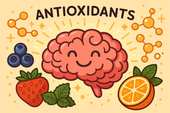
How Antioxidants Protect Emotional Well-being: The Hidden Link Between Oxidative Stress and Mental Health
Antioxidants do more than protect your body — they defend your mind. By neutralizing oxidative stress, antioxidants support serotonin, dopamine, and brain energy pathways that keep you calm, focused, and emotionally balanced. Discover how foods like berries, green tea, and dark chocolate nourish your brain, boost mood, and strengthen resilience from the inside out. 🌿✨
-
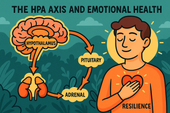
The HPA Axis and Emotional Health: The Hidden Bridge Between Stress and Mind
Neuroplasticity — the brain’s ability to rewire and adapt — is the foundation of emotional healing and resilience. When you face stress, trauma, or change, your neural pathways can reshape themselves to support new patterns of calm, focus, and self-awareness. Learn how daily practices like mindfulness, therapy, and breathwork strengthen neuroplasticity to transform emotional pain into personal growth. 🌸
-
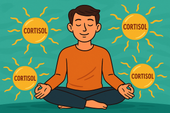
Why Cortisol Control Is Key to Resilience: Mastering Stress to Build Emotional Strength
Controlling cortisol — the body’s main stress hormone — is the secret to lasting resilience. When cortisol levels stay balanced, your mind becomes clearer, emotions steadier, and energy more sustainable. Learn how breathwork, mindset shifts, adaptogens, and daily rhythms can help you calm your stress response and build true inner strength. 🌞💪
-
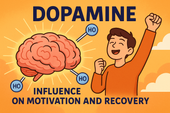
Dopamine’s Influence on Motivation and Recovery: Reigniting Drive and Balance
Healthy relationships are the foundation of emotional balance and resilience. Whether romantic, familial, or platonic, genuine connection releases dopamine, serotonin, and oxytocin — the brain’s “bonding trio” — helping us feel secure, motivated, and seen. Learn how trust, empathy, and communication not only strengthen your connections but also reshape your nervous system for deeper emotional well-being. 🌿🤝
-
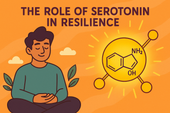
The Role of Serotonin in Resilience: How This “Mood Molecule” Shapes Emotional Strength
Serotonin — often called the “resilience molecule” — plays a vital role in how we handle stress, regulate mood, and recover from emotional challenges. Beyond happiness, this powerful neurotransmitter helps balance the gut-brain axis, stabilize the nervous system, and support emotional flexibility. Learn how nutrition, sunlight, mindfulness, and adaptogens can naturally boost serotonin and strengthen your emotional resilience. 🌞🧠
-

How Neuroplasticity Supports Emotional Growth: Rewiring the Brain for Resilience
Neuroplasticity is the brain’s built-in power to grow, adapt, and heal — and it’s the foundation of emotional transformation. Every mindful breath, compassionate act, or reframed thought strengthens new neural pathways that support resilience and self-awareness. Learn how your brain rewires through daily habits, helping you turn emotional challenges into opportunities for growth and calm. 🌿
-

Tai Chi and Adaptogens for Mind-Body Balance: The Art of Harmonizing Energy and Resilience
Alchemy isn’t just an ancient science — it’s a timeless symbol of transformation and inner balance. By blending the physical and spiritual, alchemy teaches us that change begins from within. Just as metals are refined into gold, we too can transmute emotional pain, stress, and chaos into clarity and strength through mindful practice and self-awareness. 🌙✨
-

Cold Therapy and Emotional Control: Training the Mind Through the Body
Cold therapy isn’t just for athletes — it’s a tool for emotional mastery. By exposing your body to controlled cold, you train your nervous system to stay calm under stress, improving focus, mood, and resilience. This article explores the science of cold exposure, its impact on hormones and the vagus nerve, and how ice baths and cold showers can help you build emotional control, one breath at a time. 🧊🧘♂️
-

How Music Influences Emotional Recovery: The Healing Soundtrack of the Mind
Neuroplasticity — the brain’s ability to rewire and heal itself — is at the heart of emotional recovery. Through mindful habits, music, therapy, and consistent mental stimulation, your brain can form new connections that support resilience and well-being. Discover how neuroplasticity turns pain into growth, helping you rebuild balance, focus, and emotional strength. 🌿
-
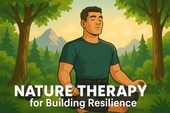
Nature Therapy for Building Resilience: Reconnecting With the Healing Power of the Earth
Nature therapy helps rebuild emotional resilience by reconnecting you with the healing rhythms of the Earth. From forest walks to sunlight exposure, nature restores balance to your nervous system, lowers stress hormones, and teaches emotional adaptability. Learn how spending time outdoors can enhance mental clarity, calm anxiety, and awaken your natural capacity to heal. 🌞
-

Breathwork Techniques That Pair with Supplements: The Ultimate Synergy for Stress Relief and Mental Clarity
Breathwork and supplements create a powerful mind-body synergy for stress relief, focus, and energy. By combining intentional breathing with adaptogens, nootropics, and calming nutrients, you can naturally regulate cortisol, sharpen mental clarity, and boost emotional balance. This guide explores the best breathwork techniques and supplement pairings to help you feel centered, calm, and energized from the inside out. 🌿
-
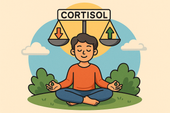
Why Cortisol Balance Matters for Emotional Strength
Balancing cortisol — your body’s main stress hormone — is essential for emotional resilience. When cortisol is chronically high, your mind stays stuck in survival mode, leading to fatigue, anxiety, and emotional instability. This article explores how nutrition, supplements, breathwork, and therapy can help restore healthy cortisol rhythms, regulate the nervous system, and strengthen your ability to handle life’s challenges with calm focus and emotional strength. 🌿
-

Best Supplements for Students During Exam Season: Focus, Energy, and Memory Support
Studying late into the night? Learn which natural supplements can boost focus, memory, and mental stamina during exam season — without the crash. From omega-3s to Bacopa and Rhodiola, discover your brain’s ultimate exam support stack. 🎓🧠
-

Natural Memory Boosters for Seniors: How to Keep Your Mind Sharp and Focused
Stay mentally sharp and confident as you age. Discover science-backed natural supplements and lifestyle habits that boost memory, focus, and brain longevity for seniors. 🌿🧠
-
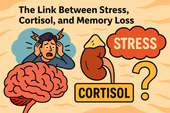
The Link Between Stress, Cortisol, and Memory Loss
Chronic stress can quietly erode your memory — and cortisol is the key culprit. Learn how stress hormones affect the brain, why the hippocampus shrinks under pressure, and how natural strategies can help you restore memory and mental clarity. 🧠✨
-

How to Build a Daily Supplement Routine for Memory Health
Want to sharpen your memory and stay mentally clear? Learn how to build a daily supplement routine for memory health — from morning focus to nighttime brain repair. Discover science-backed nutrients that boost recall, focus, and long-term cognitive resilience. 🧠🌿
-
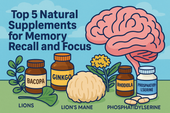
Top 5 Natural Supplements for Memory Recall and Focus
Looking to boost memory and concentration naturally? Discover the top 5 supplements — Bacopa, Ginkgo Biloba, Lion’s Mane, Rhodiola, and Phosphatidylserine — that enhance focus, recall, and long-term brain health. 🧠✨
-

Top Supplements to Balance Mood Naturally
From omega-3s to adaptogens, discover the top natural supplements proven to support emotional balance, reduce stress, and promote inner calm — safely and effectively. 🌿✨
-

Can Omega-3 Fatty Acids Help with Mood Disorders?
Omega-3 fatty acids do more than support heart health — they can help balance mood, reduce depression, and calm anxiety. Discover how EPA and DHA nourish your brain, fight inflammation, and support emotional well-being from within. 🌊🧠
-

Vitamin D and Mood: The Sunshine Vitamin for Emotional Balance
Could the key to emotional balance be as simple as a little sunlight? Discover how vitamin D — the sunshine vitamin — influences serotonin, reduces inflammation, and helps you feel more positive and resilient year-round. ☀️💛
-

The Role of Magnesium in Reducing Irritability and Low Mood
Feeling on edge or emotionally drained? Magnesium could be the missing link between your body and your mood. Discover how this essential mineral reduces irritability, balances neurotransmitters, and helps your nervous system find calm again. 🌿✨
-
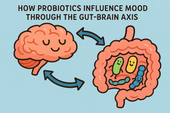
How Probiotics Influence Mood Through the Gut-Brain Axis
Discover how probiotics can do more than support your digestion—they can actually uplift your mood. This article explores the fascinating gut-brain axis and how balancing your gut bacteria through probiotics may help reduce anxiety, improve emotional stability, and support long-term mental well-being. 🌿🧠
-
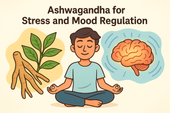
Ashwagandha for Stress and Mood Regulation
Discover how Ashwagandha, the powerful adaptogenic herb 🌿, helps your body manage stress and regulate mood. Learn how it balances cortisol, boosts GABA and serotonin, and supports emotional stability — helping you feel calm, focused, and resilient every day.
-

St. John’s Wort: Natural Support for Mild to Moderate Depression
Discover how St. John’s Wort, the “sunshine herb” 🌼, naturally supports mild to moderate depression. Learn how it boosts serotonin, balances mood, and promotes emotional resilience — with research showing its effectiveness compares to antidepressants, but with fewer side effects.
-
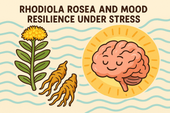
Rhodiola Rosea and Mood Resilience Under Stress
Discover how Rhodiola rosea helps your body adapt to stress 🌿. Learn how this powerful adaptogen balances cortisol, supports serotonin and dopamine, and strengthens emotional resilience — helping you stay calm, focused, and energized under pressure.
-

Chamomile and Lavender: Herbal Calm for Emotional Fluctuations
Discover how chamomile and lavender bring calm to emotional ups and downs 🌿. Learn how these two soothing herbs balance your nervous system, ease anxiety, and support restful sleep — naturally helping you find peace and emotional stability.
-

Saffron Extract and Its Surprising Benefits for Mood Disorders
Discover how saffron extract — the golden spice of joy 🌸 — can naturally support mood balance, ease anxiety, and lift mild depression. Learn what science says about its serotonin-boosting power, the ideal dosage, and how this ancient remedy compares to modern antidepressants.
-
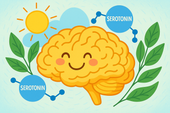
5-HTP and Serotonin: A Natural Path to Lifting Mood
Discover how 5-HTP naturally boosts serotonin 🌞 — the neurotransmitter behind mood, sleep, and emotional balance. Learn how this plant-derived compound supports happiness, reduces anxiety, and improves rest by helping your brain create more serotonin the gentle, natural way.
-

GABA Supplements for Reducing Anxiety and Mood Swings
Discover how GABA supplements can help reduce anxiety and balance mood naturally 🌿. Learn how this calming neurotransmitter works to quiet the mind, ease stress, and improve sleep — plus which nutrients and habits can boost your body’s own GABA production for long-term emotional stability.
-
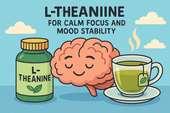
L-Theanine for Calm Focus and Mood Stability
Discover how L-theanine, the calming compound found in green tea 🍵, promotes focus, relaxation, and mood stability. Learn the science behind how it balances neurotransmitters, reduces stress hormones, and enhances clarity — helping you stay centered, calm, and productive without sedation.
-
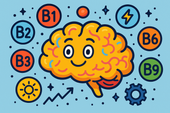
B Vitamins and Brain Chemistry: Supporting Energy and Emotional Balance
Discover how B vitamins power your brain chemistry ⚡. Learn how B6, B9, and B12 support serotonin, dopamine, and energy production — helping boost focus, mood, and emotional balance. From diet to supplements, explore how this vital nutrient group keeps your mind resilient and your energy steady.
-

N-Acetyl Cysteine (NAC) and Mood Disorders: What the Research Says
Learn how N-Acetyl Cysteine (NAC) supports brain health and mood balance 🧠. Discover how this antioxidant helps reduce oxidative stress, regulate glutamate, and improve emotional stability in depression, bipolar disorder, and anxiety — backed by cutting-edge psychiatric research.
-

Supplements for Bipolar Disorder: What May Support Stability
Discover the best supplements for bipolar disorder 🌿 that may support emotional stability and brain health. Learn how nutrients like omega-3s, magnesium, vitamin D, and NAC can help reduce inflammation, balance neurotransmitters, and complement traditional treatment safely.

















































